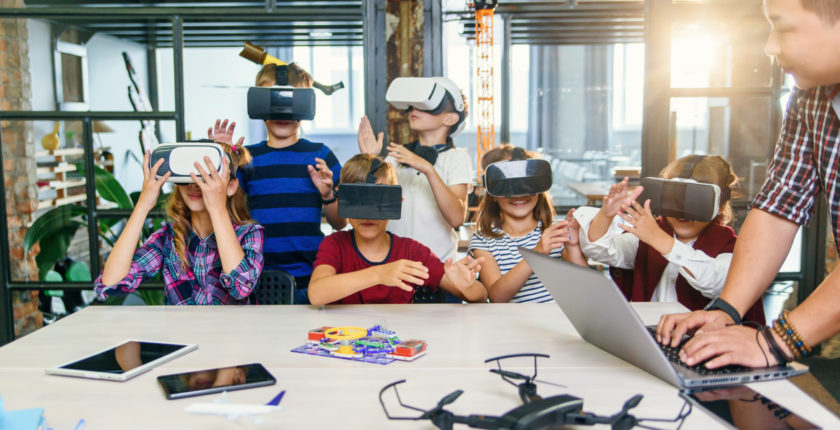Ever since Mark Zuckerberg changed the name of Facebook to Meta in October 2021, the term “metaverse” has become popular. The metaverse, which some have dubbed the internet’s future, is accessible via virtual reality (VR) and augmented reality (AR) headsets, as well as through phones, gaming consoles, and connected devices. A few firms are reinventing the future of education by attempting to include the metaverse into regular learning now that online learning has become widely accepted.
The Brief Of Metaverse
For a long time, the Metaverse has been the focus of attention for teachers. With Facebook’s statement that it was rebranding and promoting itself as Meta, this field saw a surge in interest. Combining the prefix “meta,” which denotes transcendence, with the word “universe,” which refers to a parallel or virtual environment connected to the real world, creates the term “metaverse.”
The concept “metaverse” was first used in 1992 by science fiction author Neal Stephenson in his book Snow Crash, which imagines a virtual reality-based replacement for the Internet. In this book, characters try to escape the suffering of the real world by interacting with various digital avatars and exploring a virtual world.
How Can Metaverse Effect The Education System
The way we educate children and equip teachers must advance to meet these new development opportunities as technology advances, bringing them new immersive and envisioned worlds. Researcher, professor, policymaker, and digital designer opportunities exist now while the metaverse infrastructure is still being developed, giving them the chance to pave the way rather than get swept away. Experiential virtual learning systems are essential in enabling students to take part in intensely dynamic and captivating live classroom sessions throughout the ongoing and post-epidemic, with the metaverse as the future.
Learners, teachers, and parents can now engage and communicate from the comfort of their own homes because of technology. Students and teachers have more freedom to pace the curriculum, hold meetings, and enhance practical learning experiences even when they are not on campus owing to virtual world tools and blended learning models.
Teaching online shouldn’t just entail videotaping a typical lecture and putting it online or using a streaming platform to deliver the same session the instructor would give in person. Teaching and learning strategies that actively include students in a rewarding and engaging educational experience are necessary for effective education.
What The Metaverse Can Offer Teachers
He claims that the use of the metaverse in education can address several challenges, including a lack of infrastructure, a teacher shortage, problems with access and inclusion, and students slipping out of the official educational system. Additionally, the list below explains several advantages that this technological breakthrough can provide for both students and teachers–
- Better Communication
Building interest and communication is difficult while learning online. Both students and teachers may feel lonely and isolated as a result of physical distance. The metaverse enables professors to create rooms where in-depth conversations can take place to counteract these attitudes and promote communication among participants. Teaching is also a two-way process in which both the teacher and the learners are involved. Students can choose study spaces where they can communicate, learn, and socialize at the same time.
- Improved Learning Process
Teachers can create spaces that suit their educational requirements. At the same time, completely customizable avatars allow students to interact with real-world objects and apply the theory. Additionally, giving students the option to use authentic avatars of themselves rather than crude sketches provides the virtual classroom with a more realistic sense, retaining students’ attention in the learning process. By enabling students to explore historical locations or conduct risky experiments in a safe environment, virtual reality can improve conventional educational practices in the classroom.
- Immersive Environment
The primary technologies that underpin the metaverse are virtual and augmented reality (VR). Users can fully immerse themselves in the virtual environment using specialized headgear and/or eyewear. Since it enables people to apply the theoretical principles in realistic surroundings, efficiently retain knowledge, and boost engagement, interactive education has a lot to offer to online learners. Using VR, AR, and 3D drawings, students can engage in simulations and events as if they were present physically.
Using virtual reality goggles, students and teachers may connect in the digital world regardless of where they are in the physical world. So a metaverse school’s visual potential appears. In an immersive 3D setting, the teacher can simultaneously discuss discoveries with the class and demonstrate them to the students.
- Gamified Learning
Gamified learning makes education easier and more pleasant, increases problem-solving abilities, offers real-time feedback and helps the whole cognitive development. As virtual learning environments become more realistic and learning itself becomes more engaging and immersive, e-learning will be significantly improved by the metaverse. Even if we can only speculate about what lies ahead, it will be fascinating to watch as innovations and improvements materialize.
In The Crux
Although it is merely a delivery method, technology has the potential to solve many issues. Even though the metaverse has made it simple to learn across industries and the educational system, changes are still being made in this area to make it more accessible to those who need it the most in the current age of digitalization.









